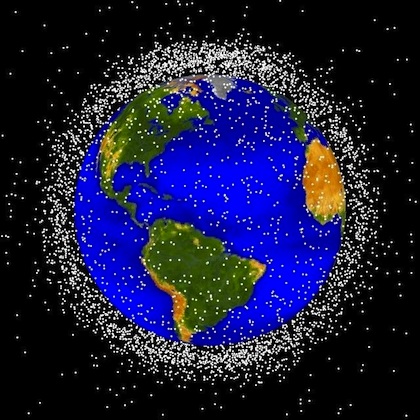Space Junk Gets Academic Focus at U Maryland
- By Dian Schaffhauser
- 05/22/14
The study of space garbage has found an academic home. The University of Maryland says it has established the Center for Orbital Debris Education and Research (CODER) to act as a hub for academic, industry and government research collaboration on the topic of space debris. The new center resides within the School of Engineering.
Currently, 22,000 pieces of space junk — human-discarded objects 10 centimeters or larger — are being tracked within Earth's orbit by the United States Space Surveillance division.
However, that isn't the sum-total of the problem. According to CODER, a "much larger junkyard of smaller debris" is also afloat in space, posing threats to satellites performing communications, weather forecasting, science exploration, Earth observation and other activities.
| |

A computer-generated image of objects in Earth orbit that are currently being tracked--about 95 percent of which are orbital debris, not functional satellites.
Photo source: NASA Orbital Debris Program Office |
|
On top of that, there's always the risk of being pelted by something falling out of space. According to NASA's Orbital Debris Program Office, during the past 50 years "an average of one cataloged piece of debris fell back to Earth each day." None of that has caused any "serious injury or significant property damage," at least according to what's been reported.
The NASA office estimates that the number of particles between one and 10 centimeters is about 500,000; those smaller than a centimeter could exceed 100 million. This space garbage consists of "derelict spacecraft and upper stages of launch vehicles, carriers for multiple payloads, debris intentionally released during spacecraft separation from its launch vehicle or during mission operations, debris created as a result of spacecraft or upper stage explosions or collisions, solid rocket motor effluents, and tiny flecks of paint released by thermal stress or small particle impacts."
CODER is the first academically led center established "to address the full range of issues surrounding the orbital debris problem," said Raymond Sedwick, founding faculty member and associate professor of aerospace engineering. "Most existing organizations focus on just one aspect of the problem — tracking, modeling, remediation, mitigation, policy, etc. CODER will serve as a research collective to provide expertise in all of these areas."
Sedwick, who also directs the university's Space Power and Propulsion Laboratory, said CODER would work to raise awareness and financial support for the problem and to do research on how to track and manage the debris. "The University of Maryland is well-positioned to take the lead in creating a multi-disciplinary, multi-organizational, collaborative research center that will pursue orbital debris solutions through research in new technologies, policies and economic solutions."
CODER will also act as a clearinghouse of data, knowledge and findings.
Currently, the work of reducing the creation of new debris has become a voluntary endeavor undertaken by spacecraft makers and operators. However, the center noted, there's no system in place to remove or clean up near-Earth orbit, nor is there a program to address the long-term environmental state of space.
About the Author
Dian Schaffhauser is a former senior contributing editor for 1105 Media's education publications THE Journal, Campus Technology and Spaces4Learning.